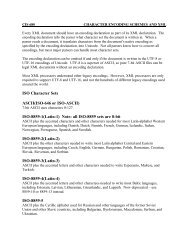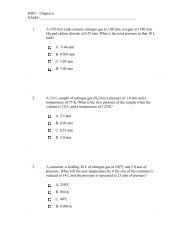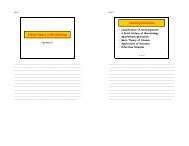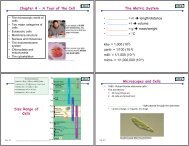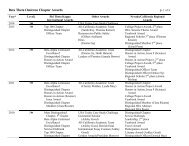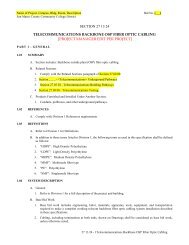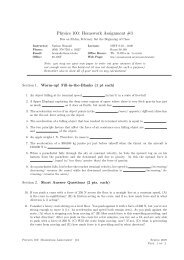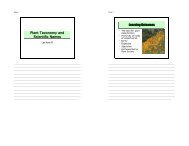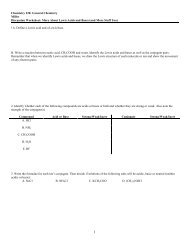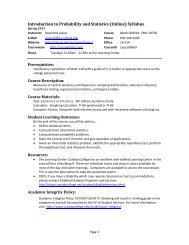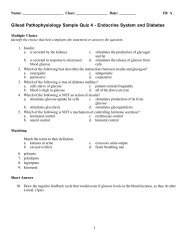9221 MULTIPLE-TUBE FERMENTATION TECHNIQUE FOR ...
9221 MULTIPLE-TUBE FERMENTATION TECHNIQUE FOR ...
9221 MULTIPLE-TUBE FERMENTATION TECHNIQUE FOR ...
Create successful ePaper yourself
Turn your PDF publications into a flip-book with our unique Google optimized e-Paper software.
9-48 MICROBIOLOGICAL EXAMINATION (9000)<br />
<strong>9221</strong> <strong>MULTIPLE</strong>-<strong>TUBE</strong> <strong>FERMENTATION</strong> <strong>TECHNIQUE</strong> <strong>FOR</strong> MEMBERS OF THE<br />
COLI<strong>FOR</strong>M GROUP*<br />
The coliform group consists of several genera of bacteria<br />
belonging to the family Enterobacteriaceae. The historical definition<br />
of this group has been based on the method used for<br />
detection (lactose fermentation) rather than on the tenets of<br />
systematic bacteriology. Accordingly, when the fermentation<br />
technique is used, this group is defined as all facultative anaerobic,<br />
gram-negative, non-spore-forming, rod-shaped bacteria<br />
* Approved by Standard Methods Committee, A–E, 1999; F, 2001.<br />
Joint Task Group: (<strong>9221</strong>C): Eugene W. Rice (chair), Paul S. Berger, James A.<br />
Clark, Stephen C. Edberg, Wallace E. Garthright, Nancy H. Hall, Shundar Lin;<br />
(<strong>9221</strong>F): Mark C. Meckes (chair), Paul S. Berger, James A. Clark, Wallace E.<br />
Garthright, Nancy H. Hall, Shundar Lin.<br />
<strong>9221</strong> A. Introduction<br />
that ferment lactose with gas and acid formation within 48 h at<br />
35°C.<br />
The standard test for the coliform group may be carried out<br />
either by the multiple-tube fermentation technique or presenceabsence<br />
procedure (through the presumptive-confirmed phases<br />
or completed test) described herein, by the membrane filter (MF)<br />
technique (Section 9222) or by the enzymatic substrate coliform<br />
test (Section 9223). Each technique is applicable within the<br />
limitations specified and with due consideration of the purpose<br />
of the examination. Production of valid results requires strict<br />
adherence to quality control procedures. Quality control guidelines<br />
are outlined in Section 9020.<br />
When multiple tubes are used in the fermentation technique,<br />
results of the examination of replicate tubes and dilutions are
<strong>MULTIPLE</strong>-<strong>TUBE</strong> <strong>FERMENTATION</strong> <strong>TECHNIQUE</strong> (<strong>9221</strong>)/Standard Total Coliform Fermentation Technique 9-49<br />
reported in terms of the Most Probable Number (MPN) of<br />
organisms present. This number, based on certain probability<br />
formulas, is an estimate of the mean density of coliforms in the<br />
sample. Coliform density, together with other information obtained<br />
by engineering or sanitary surveys, provides the best<br />
assessment of water treatment effectiveness and the sanitary<br />
quality of source water.<br />
The precision of each test depends on the number of tubes<br />
used. The most satisfactory information will be obtained when<br />
the largest sample inoculum examined shows gas in some or all<br />
of the tubes and the smallest sample inoculum shows no gas in<br />
all or a majority of the tubes. Bacterial density can be estimated<br />
by the formula given or from the table using the number of<br />
positive tubes in the multiple dilutions (<strong>9221</strong>C.2). The number of<br />
sample portions selected will be governed by the desired precision<br />
of the result. MPN tables are based on the assumption of a<br />
Poisson distribution (random dispersion). However, if the sample<br />
is not adequately shaken before the portions are removed or<br />
if clumping of bacterial cells occurs, the MPN value will be an<br />
underestimate of the actual bacterial density.<br />
1. Water of Drinking Water Quality<br />
When drinking water is analyzed to determine if the quality<br />
meets the standards of the U.S. Environmental Protection<br />
Agency (EPA), use the fermentation technique with 10 replicate<br />
tubes each containing 10 mL, 5 replicate tubes each containing<br />
20 mL, or a single bottle containing a 100-mL sample portion.<br />
When examining drinking water by the fermentation technique,<br />
process all tubes or bottles demonstrating growth with or without<br />
a positive acid or gas reaction to the confirmed phase (<strong>9221</strong>B.2).<br />
Apply the completed test (<strong>9221</strong>B.3) to not less than 10% of all<br />
coliform-positive samples per quarter. Obtain at least one positive<br />
sample per quarter. A positive EC broth (<strong>9221</strong>E) or a<br />
positive EC MUG broth (<strong>9221</strong>F) test result is considered an<br />
alternative to the positive completed test phase.<br />
For the routine examination of public water supplies the object<br />
of the total coliform test is to determine the efficiency of treatment<br />
plant operation and the integrity of the distribution system.<br />
It is also used as a screen for the presence of fecal contamination.<br />
1. Presumptive Phase<br />
A high proportion of coliform occurrences in a distribution<br />
system may be attributed not to treatment failure at the plant or<br />
the well source, but to bacterial regrowth in the mains. Because<br />
it is difficult to distinguish between coliform regrowth and new<br />
contamination, assume all coliform occurrences to be new contamination<br />
unless otherwise demonstrated.<br />
2. Water of Other than Drinking Water Quality<br />
In the examination of nonpotable waters inoculate a series of<br />
tubes with appropriate decimal dilutions of the water (multiples<br />
and submultiples of 10 mL), based on the probable coliform<br />
density. Use the presumptive-confirmed phase of the multipletube<br />
procedure. Use the more labor-intensive completed test<br />
(<strong>9221</strong>B.3) as a quality control measure on at least 10% of<br />
coliform-positive nonpotable water samples on a seasonal basis.<br />
The object of the examination of nonpotable water generally is to<br />
estimate the density of bacterial contamination, determine a<br />
source of pollution, enforce water quality standards, or trace the<br />
survival of microorganisms. The multiple-tube fermentation<br />
technique may be used to obtain statistically valid MPN estimates<br />
of coliform density. Examine a sufficient number of samples<br />
to yield representative results for the sampling station.<br />
Generally, the geometric mean or median value of the results of<br />
a number of samples will yield a value in which the effect of<br />
sample-to-sample variation is minimized.<br />
3. Other Samples<br />
The multiple-tube fermentation technique is applicable to the<br />
analysis of salt or brackish waters as well as muds, sediments,<br />
and sludges. Follow the precautions given above on portion sizes<br />
and numbers of tubes per dilution.<br />
To prepare solid or semisolid samples weigh the sample and<br />
add diluent to make a 10 1 dilution. For example, place 50 g<br />
sample in sterile blender jar, add 450 mL sterile phosphate buffer<br />
or 0.1% peptone dilution water, and blend for 1 to 2 min at low<br />
speed (8000 rpm). Prepare the appropriate decimal dilutions of<br />
the homogenized slurry as quickly as possible to minimize<br />
settling.<br />
<strong>9221</strong> B. Standard Total Coliform Fermentation Technique<br />
Use lauryl tryptose broth in the presumptive portion of the<br />
multiple-tube test. If the medium has been refrigerated after<br />
sterilization, incubate overnight at room temperature (20°C)<br />
before use. Discard tubes showing growth and/or bubbles.<br />
a. Reagents and culture medium:<br />
1) Lauryl tryptose broth:<br />
Tryptose...................................................... 20.0 g<br />
Lactose ....................................................... 5.0 g<br />
Dipotassium hydrogen phosphate, K 2HPO 4.............. 2.75 g<br />
Potassium dihydrogen phosphate, KH 2PO 4 .............. 2.75 g<br />
Sodium chloride, NaCl ..................................... 5.0 g<br />
Sodium lauryl sulfate....................................... 0.1 g<br />
Reagent-grade water ......................................... 1 L<br />
Add dehydrated ingredients to water, mix thoroughly, and heat<br />
to dissolve. pH should be 6.8 0.2 after sterilization. Before<br />
sterilization, dispense sufficient medium, in fermentation tubes<br />
with an inverted vial, to cover inverted vial at least one-half to<br />
two-thirds after sterilization. Alternatively, omit inverted vial<br />
and add 0.01 g/L bromcresol purple to presumptive medium to<br />
determine acid production, the indicator of a positive result in<br />
this part of the coliform test. Close tubes with metal or heatresistant<br />
plastic caps.
9-50 MICROBIOLOGICAL EXAMINATION (9000)<br />
Inoculum<br />
mL<br />
Make lauryl tryptose broth of such strength that adding 100mL,<br />
20-mL, or 10-mL portions of sample to medium will not<br />
reduce ingredient concentrations below those of the standard<br />
medium. Prepare in accordance with Table <strong>9221</strong>:I.<br />
b. Procedure:<br />
1) Arrange fermentation tubes in rows of five or ten tubes each<br />
in a test tube rack. The number of rows and the sample volumes<br />
selected depend upon the quality and character of the water to be<br />
examined. For potable water use five 20-mL portions, ten 10-mL<br />
portions, or a single bottle of 100 mL portion; for nonpotable<br />
water use five tubes per dilution (of 10, 1, 0.1 mL, etc.).<br />
In making dilutions and measuring diluted sample volumes,<br />
follow the precautions given in Section 9215B.2. Use Figure<br />
9215:1 as a guide to preparing dilutions. Shake sample and<br />
dilutions vigorously about 25 times. Inoculate each tube in a set<br />
of five with replicate sample volumes (in increasing decimal<br />
dilutions, if decimal quantities of the sample are used). Mix test<br />
portions in the medium by gentle agitation.<br />
2) Incubate inoculated tubes or bottles at 35 0.5C. After 24<br />
2 h swirl each tube or bottle gently and examine it for growth,<br />
gas, and acidic reaction (shades of yellow color) and, if no gas or<br />
acidic reaction is evident, reincubate and reexamine at the end of<br />
48 3 h. Record presence or absence of growth, gas, and acid<br />
production. If the inner vial is omitted, growth with acidity<br />
signifies a positive presumptive reaction.<br />
c. Interpretation: Production of an acidic reaction or gas in the<br />
tubes or bottles within 48 3 h constitutes a positive presumptive<br />
reaction. Submit tubes with a positive presumptive reaction<br />
to the confirmed phase (<strong>9221</strong>B.2).<br />
The absence of acidic reaction or gas formation at the end of<br />
48 3 h of incubation constitutes a negative test. Submit<br />
drinking water samples demonstrating growth without a positive<br />
gas or acid reaction to the confirmed phase (<strong>9221</strong>B.2). An<br />
arbitrary 48-h limit for observation doubtless excludes occasional<br />
members of the coliform group that grow very slowly (see<br />
Section 9212).<br />
2. Confirmed Phase<br />
a. Culture medium: Use brilliant green lactose bile broth<br />
fermentation tubes for the confirmed phase.<br />
Brilliant green lactose bile broth:<br />
Peptone..................................................... 10.0 g<br />
Lactose ..................................................... 10.0 g<br />
TABLE <strong>9221</strong>:I. PREPARATION OF LAURYL TRYPTOSE BROTH<br />
Amount of<br />
Medium in Tube<br />
mL<br />
Volume of Medium<br />
Inoculum<br />
mL<br />
Dehydrated Lauryl<br />
Tryptose Broth<br />
Required<br />
g/L<br />
1 10 or more 11 or more 35.6<br />
10 10 20 71.2<br />
10 20 30 53.4<br />
20 10 30 106.8<br />
100 50 150 106.8<br />
100 35 135 137.1<br />
100 20 120 213.6<br />
Oxgall ...................................................... 20.0 g<br />
Brilliant green ............................................. 0.0133 g<br />
Reagent-grade water ...................................... 1 L<br />
Add dehydrated ingredients to water, mix thoroughly, and heat<br />
to dissolve. pH should be 7.2 0.2 after sterilization. Before<br />
sterilization, dispense, in fermentation tubes with an inverted<br />
vial, sufficient medium to cover inverted vial at least one-half to<br />
two-thirds after sterilization. Close tubes with metal or heatresistant<br />
plastic caps.<br />
b. Procedure: Submit all presumptive tubes or bottles showing<br />
growth, any amount of gas, or acidic reaction within 24 2hof<br />
incubation to the confirmed phase. If active fermentation or<br />
acidic reaction appears in the presumptive tube earlier than 24 <br />
2 h, transfer to the confirmatory medium; preferably examine<br />
tubes at 18 1 h. If additional presumptive tubes or bottles show<br />
active fermentation or acidic reaction at the end of a 48 3h<br />
incubation period, submit these to the confirmed phase.<br />
Gently shake or rotate presumptive tubes or bottles showing gas<br />
or acidic growth to resuspend the organisms. With a sterile loop 3.0<br />
to 3.5 mm in diameter, transfer one or more loopfuls of culture to a<br />
fermentation tube containing brilliant green lactose bile broth or<br />
insert a sterile wooden applicator at least 2.5 cm into the culture,<br />
promptly remove, and plunge applicator to bottom of fermentation<br />
tube containing brilliant green lactose bile broth. Remove and<br />
discard applicator. Repeat for all other positive presumptive tubes.<br />
Incubate the inoculated brilliant green lactose bile broth tube<br />
at 35 0.5°C. Formation of gas in any amount in the inverted<br />
vial of the brilliant green lactose bile broth fermentation tube at<br />
any time (e.g., 6 1h,24 2 h) within 48 3 h constitutes<br />
a positive confirmed phase. Calculate the MPN value from the<br />
number of positive brilliant green lactose bile tubes as described<br />
in Section <strong>9221</strong>C.<br />
c. Alternative procedure: Use this alternative only for polluted<br />
water or wastewater known to produce positive results consistently.<br />
If all presumptive tubes are positive in two or more consecutive<br />
dilutions within 24 h, submit to the confirmed phase only the<br />
tubes of the highest dilution (smallest sample inoculum) in<br />
which all tubes are positive and any positive tubes in still higher<br />
dilutions. Submit to the confirmed phase all tubes in which gas<br />
or acidic growth is produced only after 48 h.
<strong>MULTIPLE</strong>-<strong>TUBE</strong> <strong>FERMENTATION</strong> <strong>TECHNIQUE</strong> (<strong>9221</strong>)/Standard Total Coliform Fermentation Technique 9-51<br />
3. Completed Phase<br />
Figure <strong>9221</strong>:1. Schematic outline of presumptive, confirmed, and completed phases for total coliform detection.<br />
To establish the presence of coliform bacteria and to provide<br />
quality control data, use the completed test on at least 10% of<br />
positive confirmed tubes (see Figure <strong>9221</strong>:1). Simultaneous inoculation<br />
into brilliant green lactose bile broth for total coliforms<br />
and EC broth for fecal coliforms (see Section <strong>9221</strong>E below) or<br />
EC-MUG broth for Escherichia coli may be used. Consider<br />
positive EC and EC-MUG broths elevated temperature (44.5°C)<br />
results as a positive completed test response. Parallel positive brilliant<br />
green lactose bile broth cultures with negative EC or EC-MUG<br />
broth cultures indicate the presence of nonfecal coliforms.<br />
a. Culture media and reagents:<br />
1) LES Endo agar: See Section 9222B. Use 100- 15-mm<br />
petri plates.<br />
2) MacConkey agar:<br />
Peptone...................................................... 17 g<br />
Proteose peptone ........................................... 3 g<br />
Lactose ...................................................... 10 g<br />
Bile salts .................................................... 1.5 g<br />
Sodium chloride, NaCl .................................... 5 g<br />
Agar ......................................................... 13.5 g<br />
Neutral red. ................................................. 0.03 g<br />
Crystal violet ............................................... 0.001 g<br />
Reagent-grade water ....................................... 1 L<br />
Add ingredients to water, mix thoroughly, and heat to boiling<br />
to dissolve. Sterilize by autoclaving for 15 min at 121°C. Temper<br />
agar after sterilization and pour into petri plates (100 15 mm).<br />
pH should be 7.1 0.2 after sterilization.<br />
3) Nutrient agar:<br />
Peptone......................................................... 5.0 g<br />
Beef extract.................................................... 3.0 g<br />
Agar ............................................................ 15.0 g<br />
Reagent-grade water .......................................... 1 L<br />
Add ingredients to water, mix thoroughly, and heat to dissolve.<br />
pH should be 6.8 0.2 after sterilization. Before sterilization,<br />
dispense in screw-capped tubes. After sterilization, immediately<br />
place tubes in an inclined position so that the agar will<br />
solidify with a sloped surface. Tighten screw caps after cooling<br />
and store in a protected, cool storage area.<br />
4) Gram-stain reagents:<br />
a) Ammonium oxalate-crystal violet (Hucker’s): Dissolve 2 g<br />
crystal violet (90% dye content) in 20 mL 95% ethyl alcohol;<br />
dissolve 0.8 g (NH 4) 2C 2O 4H 2O in 80 mL reagent-grade water;<br />
mix the two solutions and age for 24 h before use; filter through<br />
paper into a staining bottle.<br />
b) Lugol’s solution, Gram’s modification: Grind 1 g iodine<br />
crystals and 2gKIinamortar. Add reagent-grade water, a few<br />
milliliters at a time, and grind thoroughly after each addition
9-52 MICROBIOLOGICAL EXAMINATION (9000)<br />
until solution is complete. Rinse solution into an amber glass<br />
bottle with the remaining water (using a total of 300 mL).<br />
c) Counterstain: Dissolve 2.5 g safranin dye in 100 mL 95%<br />
ethyl alcohol. Add 10 mL to 100 mL reagent-grade water.<br />
d) Acetone alcohol: Mix equal volumes of ethyl alcohol (95%)<br />
with acetone.<br />
b. Procedure:<br />
1) Using aseptic technique, streak one LES Endo agar (Section<br />
9222B.2) or MacConkey agar plate from each tube of brilliant<br />
green lactose bile broth showing gas, as soon as possible after the<br />
observation of gas. Streak plates in a manner to insure presence<br />
of some discrete colonies separated by at least 0.5 cm. Observe<br />
the following precautions when streaking plates to obtain a high<br />
proportion of successful isolations if coliform organisms are<br />
present: (a) Use a sterile 3-mm-diam loop or an inoculating<br />
needle slightly curved at the tip; (b) tap and incline the fermentation<br />
tube to avoid picking up any membrane or scum on the<br />
needle; (c) insert end of loop or needle into the liquid in the tube<br />
to a depth of approximately 0.5 cm; and (d) streak plate for<br />
isolation with curved section of the needle in contact with the<br />
agar to avoid a scratched or torn surface. Flame loop between<br />
second and third quadrants to improve colony isolation.<br />
Incubate plates (inverted) at 35 0.5°C for 24 2h.<br />
2) The colonies developing on LES Endo agar are defined as<br />
typical (pink to dark red with a green metallic surface sheen) or<br />
atypical (pink, red, white, or colorless colonies without sheen)<br />
after 24 h incubation. Typical lactose-fermenting colonies developing<br />
on MacConkey agar are red and may be surrounded by<br />
an opaque zone of precipitated bile. From each plate pick one or<br />
more typical, well-isolated coliform colonies or, if no typical<br />
colonies are present, pick two or more colonies considered most<br />
likely to consist of organisms of the coliform group, and transfer<br />
growth from each isolate to a single-strength lauryl tryptose<br />
broth fermentation tube and onto a nutrient agar slant. (The latter<br />
is unnecessary for drinking water samples.)<br />
If needed, use a colony magnifying device to provide optimum<br />
magnification when colonies are picked from the LES Endo or<br />
MacConkey agar plates. When transferring colonies, choose<br />
well-isolated ones and barely touch the surface of the colony<br />
with a flame-sterilized, air-cooled transfer needle to minimize<br />
the danger of transferring a mixed culture.<br />
Incubate secondary broth tubes (lauryl tryptose broth with<br />
inverted fermentation vials inserted) at 35 0.5°C for 24 2h;<br />
if gas is not produced within 24 2 h reincubate and examine<br />
again at 48 3 h. Microscopically examine Gram-stained preparations<br />
from those 24-h nutrient agar slant cultures corresponding<br />
to the secondary tubes that show gas.<br />
3) Gram stain technique—The Gram stain may be omitted<br />
from the completed test for potable water samples only because<br />
the occurrences of gram-positive bacteria and spore-forming<br />
organisms surviving this selective screening procedure are infrequent<br />
in drinking water.<br />
Various modifications of the Gram stain technique exist. Use<br />
the following modification by Hucker for staining smears of pure<br />
culture; include a gram-positive and a gram-negative culture as<br />
controls.<br />
Prepare separate light emulsions of the test bacterial growth<br />
and positive and negative control cultures on the same slide<br />
using drops of distilled water on the slide. Air-dry and fix by<br />
passing slide through a flame and stain for 1 min with ammonium<br />
oxalate-crystal violet solution. Rinse slide in tap water and<br />
drain off excess; apply Lugol’s solution for 1 min.<br />
Rinse stained slide in tap water. Decolorize for approximately<br />
15 to 30 s with acetone alcohol by holding slide between the<br />
fingers and letting acetone alcohol flow across the stained smear<br />
until the solvent flows colorlessly from the slide. Do not overdecolorize.<br />
Counterstain with safranin for 15 s, rinse with tap<br />
water, blot dry with absorbent paper or air dry, and examine<br />
microscopically. Gram-positive organisms are blue; gram-negative<br />
organisms are red. Results are acceptable only when controls<br />
have given proper reactions.<br />
c. Interpretation: Formation of gas in the secondary tube of<br />
lauryl tryptose broth within 48 3 h and demonstration of<br />
gram-negative, nonspore-forming, rod-shaped bacteria from the<br />
agar culture constitute a positive result for the completed test,<br />
demonstrating the presence of a member of the coliform group.<br />
4. Bibliography<br />
MEYER, E.M. 1918. An aerobic spore-forming bacillus giving gas in<br />
lactose broth isolated in routine water examination. J. Bacteriol.<br />
3:9.<br />
HUCKER, G.J. & H.J. CONN. 1923. Methods of Gram Staining. N.Y. State<br />
Agr. Exp. Sta. Tech. Bull. No. 93.<br />
NORTON, J.F. & J.J. WEIGHT. 1924. Aerobic spore-forming lactose fermenting<br />
organisms and their significance in water analysis. Amer. J.<br />
Pub. Health 14:1019.<br />
HUCKER, G.J. & H.J. CONN. 1927. Further Studies on the Methods of<br />
Gram Staining. N.Y. State Agr. Exp. Sta. Tech. Bull. No. 128.<br />
PORTER, R., C.S. MCCLESKEY &M.LEVINE. 1937. The facultative sporulating<br />
bacteria producing gas from lactose. J. Bacteriol. 33:163.<br />
COWLES, P.B. 1939. A modified fermentation tube. J. Bacteriol. 38:677.<br />
SHERMAN, V.B.D. 1967. A Guide to the Identification of the Genera of<br />
Bacteria. Williams & Wilkins, Baltimore, Md.<br />
GELDREICH, E.E. 1975. Handbook for Evaluating Water Bacteriological<br />
Laboratories, 2nd ed. EPA-670/9-75-006, U.S. Environmental Protection<br />
Agency, Cincinnati, Ohio.<br />
EVANS, T.M., C.E. WAARVICK, R.J. SEIDLER & M.W. LECHEVALLIER.<br />
1981. Failure of the most-probable number technique to detect<br />
coliforms in drinking water and raw water supplies. Appl. Environ.<br />
Microbiol. 41:130.<br />
SEIDLER, R.J., T.M. EVANS, J.R. KAUFMAN, C.E. WAARVICK & M.W.<br />
LECHEVALLIER. 1981. Limitations of standard coliform enumeration<br />
techniques. J. Amer. Water Works Assoc. 73:538.<br />
GERHARDS, P., ed. 1981. Manual of Methods for General Bacteriology.<br />
American Soc. Microbiology, Washington, D.C.<br />
KRIEG, N.R. & J.G. HOLT, eds. 1984. Bergey’s Manual of Systematic<br />
Bacteriology, Vol 1. Williams & Wilkins, Baltimore, Md.<br />
GREENBERG, A.E. & D.A. HUNT, eds. 1985. Laboratory Procedures for<br />
the Examination of Seawater and Shellfish, 5th ed. American Public<br />
Health Assoc., Washington, D.C.<br />
U.S. ENVIRONMENTAL PROTECTION AGENCY. 1989. National primary drinking<br />
water regulations: analytical techniques; coliform bacteria; final<br />
rule. Federal Register 54(135):29998 (July 17, 1989).
<strong>MULTIPLE</strong>-<strong>TUBE</strong> <strong>FERMENTATION</strong> <strong>TECHNIQUE</strong> (<strong>9221</strong>)/Estimation of Bacterial Density 9-53<br />
1. Precision of the MPN Fermentation Tube Test<br />
Unless a large number of sample portions is examined, the<br />
precision of the most probable number (MPN) fermentation tube<br />
test is rather low. For example, Table <strong>9221</strong>:IV shows that the<br />
95% confidence limits are often one-third times and three times<br />
the estimate. Consequently, use caution when interpreting the<br />
sanitary significance of any single coliform result. When several<br />
samples from a given sampling point are estimated separately<br />
and the results combined in their geometric mean, the precision<br />
is greatly improved.<br />
2. Table Reading and Recording of MPN<br />
Record coliform concentration as the Most Probable Number<br />
(MPN)/100 mL. The MPN values, for a variety of positive and<br />
negative tube combinations, are given in Tables <strong>9221</strong>:II, III, and<br />
IV. The sample volumes indicated in Tables <strong>9221</strong>:II and III are<br />
chosen especially for examining finished waters. Table <strong>9221</strong>:IV<br />
illustrates MPN values for combinations of positive and negative<br />
results when five 10-mL, five 1.0-mL, and five 0.1-mL sample<br />
portion volumes are tested. If the sample portion volumes used<br />
are those found in the tables, report the value corresponding to<br />
the number of positive and negative results in the series as the<br />
MPN/100 mL, or, when appropriate, as presence or absence.<br />
When the series of decimal dilutions is different from that in the<br />
table, select the MPN value from Table <strong>9221</strong>:IV for the combination<br />
of positive results and calculate according to the following<br />
formulas:<br />
where:<br />
MPN/100 mL (Table MPN/100 mL) 10/V<br />
V volume of one sample portion at the lowest selected<br />
dilution.<br />
When more than three dilutions are used in a decimal series 1<br />
of dilutions, select the three most appropriate dilutions and refer<br />
to Table <strong>9221</strong>:IV. Several examples (a through f) illustrate<br />
correct selection.<br />
TABLE <strong>9221</strong>:II. MPN INDEX AND 95% CONFIDENCE LIMITS <strong>FOR</strong> ALL<br />
COMBINATIONS OF POSITIVE AND NEGATIVE RESULTS WHEN FIVE 20-ML<br />
No. of Tubes<br />
Giving Positive<br />
Reaction Out of<br />
5 (20 mL Each)<br />
PORTIONS ARE USED<br />
MPN<br />
Index/<br />
100 mL<br />
<strong>9221</strong> C. Estimation of Bacterial Density<br />
95% Confidence Limits<br />
(Exact)<br />
Lower Upper<br />
0 1.1 — 3.5<br />
1 1.1 0.051 5.4<br />
2 2.6 0.40 8.4<br />
3 4.6 1.0 13<br />
4 8.0 2.1 23<br />
5 8.0 3.4 —<br />
Example<br />
Volume<br />
mL<br />
10 1 0.1 0.01 0.001<br />
Combination<br />
of Positives<br />
MPN Index<br />
No./100 mL<br />
a 5 5 1 0 0 5-1-0 330<br />
b 4 5 1 0 0 4-5-1 48<br />
c 0 0 1 0 0 0-0-1 1.8<br />
d 5 4 4 1 0 4-4-1 400<br />
e 5 4 4 0 1 4-4-1 400<br />
f 5 5 5 5 2 5-5-2 54 000<br />
Select highest dilution that gives positive results in all five<br />
portions tested (no lower dilution giving any negative results)<br />
and the two next succeeding higher dilutions (Example a). If the<br />
lowest dilution tested has less than five portions with positive<br />
results, select it and the two next succeeding higher dilutions<br />
(Examples b, c).<br />
When a positive result occurs in a dilution higher than the<br />
three selected according to the foregoing rules, change the selection<br />
to the lowest dilution that has less than five positive<br />
results and the next two higher dilutions (Example d). When all<br />
the foregoing selection rules have left unselected any higher<br />
dilutions with positive results, add those higher-dilution positive<br />
results to the results for the highest selected dilution (Example<br />
e). If there were not enough higher dilutions tested to select three<br />
dilutions, then select the next lower dilution (Example f).<br />
When it is desired to summarize with a single MPN value the<br />
results from several samples, use the geometric mean or the median.<br />
The geometric mean is computed by averaging the logarithmic<br />
values; e.g., the geometric mean of A, B, and C is 10 L where<br />
L (log 10A log 10B log 10C) /3<br />
Mean values are reported as the antilog of L.<br />
Table <strong>9221</strong>:IV shows all but the very improbable positive tube<br />
combinations for a three-dilution series. In testing 10 different<br />
samples, there is a 99% chance of finding all the results among<br />
TABLE <strong>9221</strong>:III. MPN INDEX AND 95% CONFIDENCE LIMITS <strong>FOR</strong> ALL<br />
COMBINATIONS OF POSITIVE AND NEGATIVE RESULTS WHEN TEN 10-ML<br />
No. of Tubes<br />
Giving Positive<br />
Reaction Out of<br />
10 (10 mL Each)<br />
PORTIONS ARE USED<br />
MPN<br />
Index/<br />
100 mL<br />
95% Confidence<br />
Limits (Exact)<br />
Lower Upper<br />
0 1.1 — 3.4<br />
1 1.1 0.051 5.9<br />
2 2.2 0.37 8.2<br />
3 3.6 0.91 9.7<br />
4 5.1 1.6 13<br />
5 6.9 2.5 15<br />
6 9.2 3.3 19<br />
7 12 4.8 24<br />
8 16 5.8 34<br />
9 23 8.1 53<br />
10 23 13 —
9-54 MICROBIOLOGICAL EXAMINATION (9000)<br />
TABLE <strong>9221</strong>:IV. MPN INDEX AND 95% CONFIDENCE LIMITS <strong>FOR</strong> VARIOUS COMBINATIONS OF POSITIVE RESULTS WHEN FIVE <strong>TUBE</strong>S ARE USED PER DILUTION<br />
(10 ML, 1.0 ML, 0.1 ML)*<br />
Combination<br />
of Positives<br />
MPN Index/<br />
100 mL<br />
these 95 outcomes. If untabulated combinations occur with a<br />
frequency greater than 0.1%, it indicates that the technique is<br />
faulty or that the statistical assumptions underlying the MPN<br />
estimate are not being fulfilled (e.g., growth inhibition at low<br />
dilutions).<br />
The MPN for combinations not appearing in the table, or for<br />
other combinations of tubes or dilutions, may be estimated as<br />
Confidence Limits<br />
Combination MPN Index/<br />
Confidence Limits<br />
Low High of Positives<br />
100 mL<br />
Low High<br />
0-0-0 1.8 — 6.8 4-0-3 25 9.8 70<br />
0-0-1 1.8 0.090 6.8 4-1-0 17 6.0 40<br />
0-1-0 1.8 0.090 6.9 4-1-1 21 6.8 42<br />
0-1-1 3.6 0.70 10 4-1-2 26 9.8 70<br />
0-2-0 3.7 0.70 10 4-1-3 31 10 70<br />
0-2-1 5.5 1.8 15 4-2-0 22 6.8 50<br />
0-3-0 5.6 1.8 15 4-2-1 26 9.8 70<br />
1-0-0 2.0 0.10 10 4-2-2 32 10 70<br />
1-0-1 4.0 0.70 10 4-2-3 38 14 100<br />
1-0-2 6.0 1.8 15 4-3-0 27 9.9 70<br />
1-1-0 4.0 0.71 12 4-3-1 33 10 70<br />
1-1-1 6.1 1.8 15 4-3-2 39 14 100<br />
1-1-2 8.1 3.4 22 4-4-0 34 14 100<br />
1-2-0 6.1 1.8 15 4-4-1 40 14 100<br />
1-2-1 8.2 3.4 22 4-4-2 47 15 120<br />
1-3-0 8.3 3.4 22 4-5-0 41 14 100<br />
1-3-1 10 3.5 22 4-5-1 48 15 120<br />
1-4-0 10 3.5 22 5-0-0 23 6.8 70<br />
2-0-0 4.5 0.79 15 5-0-1 31 10 70<br />
2-0-1 6.8 1.8 15 5-0-2 43 14 100<br />
2-0-2 9.1 3.4 22 5-0-3 58 22 150<br />
2-1-0 6.8 1.8 17 5-1-0 33 10 100<br />
2-1-1 9.2 3.4 22 5-1-1 46 14 120<br />
2-1-2 12 4.1 26 5-1-2 63 22 150<br />
2-2-0 9.3 3.4 22 5-1-3 84 34 220<br />
2-2-1 12 4.1 26 5-2-0 49 15 150<br />
2-2-2 14 5.9 36 5-2-1 70 22 170<br />
2-3-0 12 4.1 26 5-2-2 94 34 230<br />
2-3-1 14 5.9 36 5-2-3 120 36 250<br />
2-4-0 15 5.9 36 5-2-4 150 58 400<br />
3-0-0 7.8 2.1 22 5-3-0 79 22 220<br />
3-0-1 11 3.5 23 5-3-1 110 34 250<br />
3-0-2 13 5.6 35 5-3-2 140 52 400<br />
3-1-0 11 3.5 26 5-3-3 170 70 400<br />
3-1-1 14 5.6 36 5-3-4 210 70 400<br />
3-1-2 17 6.0 36 5-4-0 130 36 400<br />
3-2-0 14 5.7 36 5-4-1 170 58 400<br />
3-2-1 17 6.8 40 5-4-2 220 70 440<br />
3-2-2 20 6.8 40 5-4-3 280 100 710<br />
3-3-0 17 6.8 40 5-4-4 350 100 710<br />
3-3-1 21 6.8 40 5-4-5 430 150 1100<br />
3-3-2 24 9.8 70 5-5-0 240 70 710<br />
3-4-0 21 6.8 40 5-5-1 350 100 1100<br />
3-4-1 24 9.8 70 5-5-2 540 150 1700<br />
3-5-0 25 9.8 70 5-5-3 920 220 2600<br />
4-0-0 13 4.1 35 5-5-4 1600 400 4600<br />
4-0-1 17 5.9 36 5-5-5 1600 700 —<br />
4-0-2 21 6.8 40<br />
* Results to two significant figures.<br />
follows: First, select the lowest dilution that does not have all<br />
positive results. Second, select the highest dilution with at least<br />
one positive result. Finally, select all the dilutions between them.<br />
For example, from (5/5, 10/10, 4/10, 1/10, 0/5) use only (–, –,<br />
4/10, 1/10, –), 4/10 @ 0.1 mL sample/tube and 1/10 @ 0.01 mL<br />
sample/tube; from (5/5, 10/10, 10/10, 0/10, 0/5) select only (–. –.<br />
10/10, 0/10, –), 10/10 @ 0.1 mL sample/tube and 0/10 @ 0.01
<strong>MULTIPLE</strong>-<strong>TUBE</strong> <strong>FERMENTATION</strong> <strong>TECHNIQUE</strong> (<strong>9221</strong>)/Presence-Absence (P-A) Coliform Test 9-55<br />
mL sample/tube. Use only the selected dilutions in the following<br />
formula of Thomas 1 :<br />
MPN/100 mL (approx.) 100 P/ (N T) 1/2<br />
where:<br />
P number of positive results,<br />
N volume of sample in all the negative portions combined,<br />
mL, and<br />
T total volume of sample in the selected dilutions, mL.<br />
In the first example above,<br />
MPN/100 mL (approx.) 100 5/ (0.69 1.1) 1/2 <br />
In the second example above,<br />
500/0.87 570/100 mL<br />
MPN/100 mL (approx.) 100 10/ (0.1 1.1) 1/2 <br />
1000/0.332 3000/100 mL<br />
The two examples compare well with the true MPNs, 590/100<br />
mL and 2400/100 mL, respectively. The second example is a<br />
special case for which an exact solution can be calculated directly<br />
for the two selected dilutions.<br />
Although MPN tables and calculations are described for use in<br />
the coliform test, they also determine the MPN of any other<br />
organisms provided that suitable test media are available.<br />
When all the results at the lower dilutions are positive and all<br />
the results at higher dilutions are negative, it is possible to<br />
calculate an exact MPN for two selected dilutions as follows:<br />
When V is the volume of each individual sample portion at the<br />
highest dilution with all positive portions,<br />
MPN/100 mL (1/V) 230.3 log 10 (T/N)<br />
where T and N are defined as for Thomas’s formula. The last<br />
example discussed above was (5/5, 10/10, 10/10, 0/10, 0/5),<br />
with portions 10, 1, 0.1, 0.01, and 0.001. The third dilution is<br />
the highest with positive portions, so V 0.1. The MPN for<br />
the third and fourth dilution would be exactly<br />
MPN/100 mL (1/0.1) 230.3 log 10 (1.1/0.1) 2400/100 mL<br />
3. Reference<br />
1. THOMAS, H.A., JR. 1942. Bacterial densities from fermentation tube<br />
tests. J. Amer. Water Works Assoc. 34:572.<br />
4. Bibliography<br />
MCCRADY, M.H. 1915. The numerical interpretation of fermentation<br />
tube results. J. Infect. Dis. 12:183.<br />
MCCRADY, M.H. 1918. Tables for rapid interpretation of fermentationtube<br />
results. Pub. Health J. 9:201.<br />
HOSKINS, J.K. 1933. The most probable numbers of B. coli in water<br />
analysis. J. Amer. Water Works Assoc. 25:867.<br />
HOSKINS, J.K. 1934. Most Probable Numbers for evaluation of coliaerogenes<br />
tests by fermentation tube method. Pub. Health Rep.<br />
49:393.<br />
HALVORSON, H.O. & N.R. ZIEGLER. 1933–35. Application of statistics to<br />
problems in bacteriology. J. Bacteriol. 25:101; 26:331, 559; 29:<br />
609.<br />
EISENHART, C. & P.W. WILSON. 1943. Statistical methods and control in<br />
bacteriology. Bacteriol. Rev. 7:57.<br />
COCHRAN, W.G. 1950. Estimation of bacterial densities by means of the<br />
“Most Probable Number.” Biometrics 6:105.<br />
WOODWARD, R.L. 1957. How probable is the Most Probable Number?<br />
J. Amer. Water Works Assoc. 49:1060.<br />
DEMAN, J.C. 1983. MPN tables, corrected. Eur. J. Appl. Biotechnol.<br />
17:301.<br />
GARTHRIGHT, W.E. 1998. Appendix 2. Most probable number from serial<br />
dilutions. FDA Bacteriological Analytical Manual, 8th ed., Rev. A.<br />
AOAC International, Gaithersburg, Md.<br />
<strong>9221</strong> D. Presence-Absence (P-A) Coliform Test<br />
The presence-absence (P-A) test for the coliform group is a<br />
simple modification of the multiple-tube procedure. Simplification,<br />
by use of one large test portion (100 mL) in a single culture<br />
bottle to obtain qualitative information on the presence or absence<br />
of coliforms, is justified on the theory that no coliforms<br />
should be present in 100 mL of a drinking water sample. The<br />
P-A test also provides the optional opportunity for further<br />
screening of the culture to isolate other indicators (fecal coliform,<br />
Aeromonas, Staphylococcus, Pseudomonas, fecal streptococcus,<br />
and Clostridium) on the same qualitative basis. Additional<br />
advantages include the possibility of examining a larger<br />
number of samples per unit of time. Comparative studies with<br />
the membrane filter procedure indicate that the P-A test may<br />
maximize coliform detection in samples containing many organisms<br />
that could overgrow coliform colonies and cause problems<br />
in detection.<br />
The P-A test is intended for use on routine samples collected<br />
from distribution systems or water treatment plants. When sample<br />
locations produce a positive P-A result for coliforms, it may<br />
be advisable to determine coliform densities in repeat samples.<br />
Quantitative information may indicate the magnitude of a contaminating<br />
event.<br />
1. Presumptive Phase<br />
a. Culture media:<br />
1) P-A broth: This medium is commercially available in<br />
dehydrated and in sterile concentrated form.<br />
Beef extract ............................................... 3.0 g<br />
Peptone .................................................... 5.0 g<br />
Lactose .................................................... 7.46 g<br />
Tryptose ................................................... 9.83 g
9-56 MICROBIOLOGICAL EXAMINATION (9000)<br />
Dipotassium hydrogen phosphate, K 2HPO 4 ........... 1.35 g<br />
Potassium dihydrogen phosphate, KH 2PO 4 ............ 1.35 g<br />
Sodium chloride, NaCl ................................... 2.46 g<br />
Sodium lauryl sulfate .................................... 0.05 g<br />
Bromcresol purple ........................................ 0.0085 g<br />
Reagent-grade water ..................................... 1 L<br />
Make this formulation triple (3) strength when examining<br />
100-mL samples. Dissolve the P-A broth medium in water<br />
without heating, using a stirring device. Dispense 50 mL prepared<br />
medium into a screw-cap 250-mL milk dilution bottle. A<br />
fermentation tube insert is not necessary. Autoclave for 12 min<br />
at 121°C with the total time in the autoclave limited to 30 min or<br />
less. pH should be 6.8 0.2 after sterilization. When the PA<br />
medium is sterilized by filtration a 6 strength medium may be<br />
used. Aseptically dispense 20 mL of the 6 medium into a<br />
sterile 250-mL dilution bottle or equivalent container.<br />
2) Lauryl tryptose broth: See Section <strong>9221</strong>B.1.<br />
b. Procedure: Shake sample vigorously for 5 s (approximately<br />
25 times) and inoculate 100 mL into a P-A culture bottle. Mix<br />
thoroughly by inverting bottle once or twice to achieve even<br />
distribution of the triple-strength medium throughout the sample.<br />
Incubate at 35 0.5°C and inspect after 24 and 48 h for acid<br />
reactions.<br />
c. Interpretation: A distinct yellow color forms in the medium<br />
when acid conditions exist following lactose fermentation. If gas<br />
also is being produced, gently shaking the bottle will result in a<br />
foaming reaction. Any amount of gas and/or acid constitutes a<br />
positive presumptive test requiring confirmation.<br />
2. Confirmed Phase<br />
The confirmed phase is outlined in Figure <strong>9221</strong>:1.<br />
a. Culture medium: Use brilliant green lactose bile fermentation<br />
tubes (see <strong>9221</strong>B.2).<br />
Elevated-temperature tests for distinguishing organisms of<br />
the total coliform group that also belong to the fecal coliform<br />
group are described herein. Modifications in technical procedures,<br />
standardization of methods, and detailed studies of the<br />
fecal coliform group have established the value of this procedure.<br />
The test can be performed by one of the multiple-tube<br />
procedures described here or by membrane filter methods as<br />
described in Section 9222. The procedure using A-1 broth is<br />
a single-step method.<br />
The fecal coliform test (using EC medium) is applicable to<br />
investigations of drinking water, stream pollution, raw water<br />
sources, wastewater treatment systems, bathing waters, seawaters,<br />
and general water-quality monitoring. Prior enrichment<br />
in presumptive media is required for optimum recovery<br />
of fecal coliforms when using EC medium. The test using A-1<br />
medium is applicable to source water, seawater, and treated<br />
wastewater.<br />
b. Procedure: Transfer all cultures that show acid reaction or<br />
acid and gas reaction to brilliant green lactose bile (BGLB) broth<br />
for incubation at 35 0.5°C (see Section <strong>9221</strong>B.2).<br />
c. Interpretation: Gas production in the BGLB broth culture<br />
within 48 3 h confirms the presence of coliform bacteria.<br />
Report result as presence-absence test positive or negative for<br />
total coliforms in 100 mL of sample.<br />
3. Completed Phase<br />
The completed phase is outlined in Section <strong>9221</strong>B.3 and<br />
Figure <strong>9221</strong>:1.<br />
4. Bibliography<br />
<strong>9221</strong> E. Fecal Coliform Procedure<br />
WEISS, J.E. & C.A. HUNTER. 1939. Simplified bacteriological examination<br />
of water. J. Amer. Water Works Assoc. 31:707.<br />
CLARK, J.A. 1969. The detection of various bacteria indicative of water<br />
pollution by a presence-absence (P-A) procedure. Can. J. Microbiol.<br />
15:771.<br />
CLARK, J.A. & L.T. VLASSOFF. 1973. Relationships among pollution<br />
indicator bacteria isolated from raw water and distribution systems<br />
by the presence-absence (P-A) test. Health Lab. Sci. 10:163.<br />
CLARK, J.A. 1980. The influence of increasing numbers of nonindicator<br />
organisms upon the detection of indicator organisms by the membrane<br />
filter and presence-absence tests. Can. J. Microbiol. 26:827.<br />
CLARK, J.A., C.A. BURGER & L.E. SABATINOS. 1982. Characterization of<br />
indicator bacteria in municipal raw water, drinking water and new<br />
main water samples. Can. J. Microbiol. 28:1002.<br />
JACOBS, N.J., W.L. ZEIGLER, F.C. REED, T.A. STUKEL & E.W. RICE. 1986.<br />
Comparison of membrane filter, multiple-fermentation-tube, and<br />
presence-absence techniques for detecting total coliforms in small<br />
community water systems. Appl. Environ. Microbiol. 51:1007.<br />
RICE, E.W., E.E. GELDREICH & E.J. READ. 1989. The presence-absence<br />
coliform test for monitoring drinking water quality. Pub. Health<br />
Rep. 104:54.<br />
1. Fecal Coliform Test (EC Medium)<br />
The fecal coliform test is used to distinguish those total<br />
coliform organisms that are fecal coliforms. Use EC medium or,<br />
for a more rapid test of the quality of shellfish waters, treated<br />
wastewaters, or source waters, use A-1 medium in a direct test.<br />
a. EC medium:<br />
Tryptose or trypticase ....................................... 20.0 g<br />
Lactose ....................................................... 5.0 g<br />
Bile salts mixture or bile salts No. 3 ...................... 1.5 g<br />
Dipotassium hydrogen phosphate, K 2HPO 4 .............. 4.0 g<br />
Potassium dihydrogen phosphate, KH 2PO 4 ............... 1.5 g<br />
Sodium chloride, NaCl ...................................... 5.0 g<br />
Reagent-grade water ........................................ 1 L<br />
Add dehydrated ingredients to water, mix thoroughly, and heat<br />
to dissolve. pH should be 6.9 0.2 after sterilization. Before<br />
sterilization, dispense in fermentation tubes, each with an inverted<br />
vial, sufficient medium to cover the inverted vial at least
<strong>MULTIPLE</strong>-<strong>TUBE</strong> <strong>FERMENTATION</strong> <strong>TECHNIQUE</strong> (<strong>9221</strong>)/Escherichia coli Procedure 9-57<br />
partially after sterilization. Close tubes with metal or heat-resistant<br />
plastic caps.<br />
b. Procedure: Submit all presumptive fermentation tubes or<br />
bottles showing any amount of gas, growth, or acidity within<br />
48 h of incubation to the fecal coliform test.<br />
1) Gently shake or rotate presumptive fermentation tubes or<br />
bottles showing gas, growth, or acidity. Using a sterile 3- or<br />
3.5-mm-diam loop or sterile wooden applicator stick, transfer<br />
growth from each presumptive fermentation tube or bottle to EC<br />
broth (see Section <strong>9221</strong>B.2).<br />
2) Incubate inoculated EC broth tubes in a water bath at 44.5<br />
0.2°C for 24 2h.<br />
Place all EC tubes in water bath within 30 min after inoculation.<br />
Maintain a sufficient water depth in water bath incubator to<br />
immerse tubes to upper level of the medium.<br />
c. Interpretation: Gas production with growth in an EC broth<br />
culture within 24 2 h or less is considered a positive fecal<br />
coliform reaction. Failure to produce gas (with little or no<br />
growth) constitutes a negative reaction. If multiple tubes are<br />
used, calculate MPN from the number of positive EC broth tubes<br />
as described in Section <strong>9221</strong>C. When using only one tube for<br />
subculturing from a single presumptive bottle, report as presence<br />
or absence of fecal coliforms.<br />
2. Fecal Coliform Direct Test (A-1 Medium)<br />
a. A-1 broth: This medium may be used for the direct isolation<br />
of fecal coliforms from water. Prior enrichment in a presumptive<br />
medium is not required.<br />
Lactose ......................................................... 5.0 g<br />
Tryptone ....................................................... 20.0 g<br />
Sodium chloride, NaCl ....................................... 5.0 g<br />
Salicin.......................................................... 0.5 g<br />
Polyethylene glycol p-isooctylphenyl ether*............... 1.0 mL<br />
Reagent-grade water .......................................... 1 L<br />
Heat to dissolve solid ingredients, add polyethylene glycol<br />
p-isooctylphenyl ether, and adjust to pH 6.9 0.1. Before<br />
* Triton X-100, Rohm and Haas Co., or equivalent.<br />
sterilization dispense in fermentation tubes with an inverted vial<br />
sufficient medium to cover the inverted vial at least partially<br />
after sterilization. Close with metal or heat-resistant plastic caps.<br />
Sterilize by autoclaving at 121°C for 10 min. Store in dark at<br />
room temperature for not longer than 7 d. Ignore formation of<br />
precipitate.<br />
Make A-1 broth of such strength that adding 10-mL sample<br />
portions to medium will not reduce ingredient concentrations<br />
below those of the standard medium. For 10-mL samples prepare<br />
double-strength medium.<br />
b. Procedure: Inoculate tubes of A-1 broth as directed in<br />
Section <strong>9221</strong>B.1b1). Incubate for 3hat35 0.5°C. Transfer<br />
tubes to a water bath at 44.5 0.2°C and incubate for an<br />
additional 21 2h.<br />
c. Interpretation: Gas production in any A-1 broth culture<br />
within 24 h or less is a positive reaction indicating the presence<br />
of fecal coliforms. Calculate MPN from the number of positive<br />
A-1 broth tubes as described in Section <strong>9221</strong>C.<br />
3. Bibliography<br />
PERRY, C.A. & A.A. HAJNA. 1933. A modified Eijkman medium. J.<br />
Bacteriol. 26:419.<br />
PERRY, C.A. & A.A. HAJNA. 1944. Further evaluation of EC medium for<br />
the isolation of coliform bacteria and Escherichia coli. Amer. J.<br />
Pub. Health 34:735.<br />
GELDREICH, E.E., H.F. CLARK, P.W. KABLER, C.B. HUFF & R.H. BORDNER.<br />
1958. The coliform group. II. Reactions in EC medium at 45°C.<br />
Appl. Microbiol. 6:347.<br />
GELDREICH, E.E., R.H. BORDNER, C.B. HUFF, H.F. CLARK & P.W. KABLER.<br />
1962. Type distribution of coliform bacteria in the feces of warmblooded<br />
animals. J. Water Pollut. Control Fed. 34:295.<br />
GELDREICH, E.E. 1966. Sanitary significance of fecal coliforms in the<br />
environment. FWPCA Publ. WP-20-3 (Nov.). U.S. Dep. Interior,<br />
Washington, D.C.<br />
ANDREWS, W.H. & M.W. PRESNELL. 1972. Rapid recovery of Escherichia<br />
coli from estuarine water. Appl. Microbiol. 23:521.<br />
OLSON, B.H. 1978. Enhanced accuracy of coliform testing in seawater by<br />
a modification of the most-probable-number method. Appl. Microbiol.<br />
36:438.<br />
STRANDRIDGE, J.H. & J.J. DELFINO. 1981. A-1 Medium: Alternative<br />
technique for fecal coliform organism enumeration in chlorinated<br />
wastewaters. Appl. Environ. Microbiol. 42:918.<br />
<strong>9221</strong> F. Escherichia coli Procedure (PROPOSED)<br />
Escherichia coli is a member of the fecal coliform group of<br />
bacteria. This organism in water indicates fecal contamination.<br />
Enzymatic and biochemical assays have been developed that<br />
allow for the identification of this organism. Assays for -glucuronidase,<br />
glutamate decarboxylase, or indole may be used to<br />
determine the presence of E. coli. For the E. coli test with<br />
EC-MUG medium, 1 below, E. coli is defined as the species of<br />
coliform bacteria possessing the enzyme -glucuronidase and<br />
capable of cleaving the fluorogenic substrate 4-methylumbelliferyl--D-glucuronide<br />
(MUG) with the corresponding release<br />
of the fluorogen when grown in EC-MUG medium at 44.5°C<br />
within 24 2 h or less. For the E.coli test with GAD reagent, <br />
2 below, the E. coli species is defined as coliform bacteria<br />
possessing the enzyme glutamate decarboxylase (GAD) and<br />
capable of producing an alkaline reaction within 4hinareagent<br />
containing a lytic agent and glutamic acid. For the E. coli test<br />
involving indole production, 3 below, the E. coli species is<br />
defined as coliform bacteria that can produce indole within 24 <br />
2 h or less when grown in tryptone water at 44.5°C . These<br />
procedures are used to confirm the presence of E. coli after prior<br />
enrichment in a presumptive medium for total coliform bacteria.<br />
These tests are performed by the tube procedure as described<br />
here or by the membrane filter method as described in Section
9-58 MICROBIOLOGICAL EXAMINATION (9000)<br />
9222. The chromogenic substrate procedure (Section 9223) can<br />
be used for direct detection of E. coli.<br />
Tests for E. coli are applicable to the analysis of drinking<br />
water, surface water, groundwater, and wastewater. E. coli is a<br />
member of the indigenous fecal flora of warm-blooded animals.<br />
The occurrence of E. coli is considered a specific indicator of<br />
fecal contamination and the possible presence of enteric pathogens.<br />
1. Escherichia coli Test (EC-MUG Medium)<br />
Use EC-MUG medium for the confirmation of E. coli.<br />
a. EC-MUG medium:<br />
Tryptose or trypticase ....................................... 20.0 g<br />
Lactose ....................................................... 5.0 g<br />
Bile salts mixture or bile salts No. 3 ...................... 1.5 g<br />
Dipotassium hydrogen phosphate, K 2HPO 4 .............. 4.0 g<br />
Potassium dihydrogen phosphate, KH 2PO 4 ............... 1.5 g<br />
Sodium chloride, NaCl ...................................... 5.0 g<br />
4-methylumbelliferyl--D-glucuronide (MUG) ........... 0.05 g<br />
Reagent-grade water ........................................ 1 L<br />
Add dehydrated ingredients to water, mix thoroughly, and heat<br />
to dissolve. pH should be 6.9 0.2 after sterilization for 15 min<br />
at 121°C. Before sterilization, dispense in tubes that do not<br />
fluoresce under long-wavelength (366 nm) ultraviolet (UV) light.<br />
An inverted tube is not necessary. Close tubes with metal or<br />
heat-resistant plastic caps.<br />
b. Procedure: Submit all presumptive fermentation tubes or<br />
bottles (<strong>9221</strong>B, <strong>9221</strong>D) showing growth, gas, or acidity within<br />
48 3 h of incubation to the E. coli test.<br />
1) Gently shake or rotate presumptive fermentation tubes or<br />
bottles showing growth, gas, or acidity. Using a sterile 3- or<br />
3.5-mm-diam metal loop or sterile wooden applicator stick,<br />
transfer growth from presumptive fermentation tube or bottle to<br />
EC-MUG broth.<br />
2) Incubate inoculated EC-MUG tubes in a water bath maintained<br />
at 44.5 0.2°C for 24 2 h. Place all EC-MUG tubes in<br />
water bath within 30 min after inoculation. Maintain a sufficient<br />
water depth in the water-bath incubator to immerse tubes to<br />
upper level of medium.<br />
c. Interpretation: Examine all tubes exhibiting growth for<br />
fluorescence using a long-wavelength UV lamp (preferably 6<br />
W). The presence of bright blue fluorescence is considered a<br />
positive response for E. coli. A positive control consisting of a<br />
known E. coli (MUG-positive) culture, a negative control consisting<br />
of a thermotolerant Klebsiella pneumoniae (MUG-negative)<br />
culture, and an uninoculated medium control may be necessary<br />
to interpret the results and to avoid confusion of weak<br />
autofluorescence of the medium as a positive response. If multiple<br />
tubes are used, calculate MPN from the number of positive<br />
EC-MUG broth tubes as described in Section <strong>9221</strong>C. When<br />
using only one tube or subculturing from a single presumptive<br />
bottle, report as presence or absence of E. coli.<br />
2. Escherichia coli Test (GAD Procedure)<br />
Use GAD reagent for the confirmation of E. coli.<br />
a. GAD reagent:<br />
L-glutamic acid ................................................. 1.0 g<br />
Sodium chloride, NaCl ....................................... 90.0 g<br />
Bromocresol green............................................. 0.05 g<br />
Polyethylene glycol octylphenyl ether*....................... 3.0 mL<br />
Reagent-grade water ............................................ 1 L<br />
Add ingredients to water and mix thoroughly until all ingredients<br />
are dissolved. pH should be 3.4 0.2. The reagent is<br />
stable for 2 months when stored at 5° C. It can be filter-sterilized<br />
(0.2-m filter) and treated as a sterile solution.<br />
b. Procedure: Submit all presumptive fermentation tubes or<br />
bottles (<strong>9221</strong>B, <strong>9221</strong>D) showing growth, gas, or acidity within<br />
48 3 h of incubation to the E. coli test.<br />
1) Gently shake or rotate presumptive tubes or bottles showing<br />
growth, gas, or acidity. Using a graduated pipet, transfer 5<br />
mL broth from the fermentation tube or bottle to 15-mL centrifuge<br />
tube.<br />
2) Concentrate the bacterial cells from the broth by centrifugation<br />
at 2500 to 3000 g for 10 min. Discard supernatant and<br />
resuspend cells in 5 mL phosphate buffer. Reconcentrate cells by<br />
centrifugation ( 2500 to 3000 g, 10 min). Discard supernatant<br />
and add 1.0 mL GAD reagent. Vigorously swirl the tube to<br />
resuspend cells in GAD reagent.<br />
3) Incubate tubes at 35°C and observe after 1 h. Tubes may be<br />
incubated for a maximum of 4 h.<br />
c. Interpretation: Examine all tubes for a distinct color change<br />
from yellow to blue. The presence of a blue color is considered<br />
a positive response for E. coli. A positive control consisting of a<br />
known E. coli (GAD-positive) culture, a negative control consisting<br />
of a known total coliform organism, e.g., Enterobacter<br />
cloacae (GAD-negative), and an uninoculated GAD reagent<br />
control may be incorporated in the assay to assist in interpretation<br />
of results. If multiple tubes are used, calculate MPN from<br />
the number of positive GAD tubes as described in Section<br />
<strong>9221</strong>C. When using only one tube or a single presumptive bottle,<br />
report as presence or absence of E. coli.<br />
3. Escherichia coli Test (Indole Production)<br />
Use tryptone water and Kovacs’ reagent for confirmation of E.<br />
coli.<br />
a. Reagents:<br />
1) Tryptone water:<br />
Tryptone ......................................................... 20 g<br />
Sodium chloride, NaCl ......................................... 5 g<br />
Reagent-grade water ............................................ 1 L<br />
Add ingredients to water and mix thoroughly until dissolved.<br />
Adjust pH to 7.5. Dispense 5-mL portions into tubes, cap, and<br />
sterilize for 10 min at 115°C.<br />
2) Kovacs’ reagent:<br />
p-Dimethylaminobenzaldehyde .............................. 5 g<br />
Amyl alcohol (analytical grade) ............................ 75 mL<br />
Hydrochloric acid, conc ..................................... 25 mL<br />
* Triton X-100, Union Carbide Co., or equivalent.
MEMBRANE FILTER <strong>TECHNIQUE</strong> (9222)/Introduction 9-59<br />
Dissolve aldehyde in alcohol. Cautiously add acid to aldehyde-alcohol<br />
mixture and swirl to mix. Store in the dark at 4°C.<br />
This reagent should be pale yellow to light brown in color. Use<br />
of low-quality amyl alcohol may produce a dark-colored reagent;<br />
do not use such a reagent.<br />
b. Procedure: Submit all presumptive fermentation tubes or<br />
bottles (<strong>9221</strong>B) showing growth, gas, or acidity within 48 3 h<br />
of incubation to the E. coli test.<br />
Gently shake or rotate presumptive tubes or bottles showing<br />
growth, gas, or acidity. Using a sterile 3- or 3.5-mm-diam metal<br />
loop or sterile wooden applicator stick, transfer growth from<br />
presumptive fermentation tube or bottle to a tube containing 5<br />
mL tryptone water. Incubate inoculated tryptone water tubes in<br />
a water bath or incubator maintained at 44.5°C for 24 2h.<br />
After incubation, add 0.2 to 0.3 mL Kovacs’ reagent to each tube<br />
of tryptone water.<br />
c. Interpretation: Examine all tubes for appearance of a deep<br />
red color in the upper layer. The presence of a red color is<br />
considered a positive response for E. coli. A positive control<br />
consisting of a known E. coli (indole-positive) culture, a negative<br />
control consisting of a known total coliform organism, e.g.,<br />
Enterobacter cloacae (indole-negative), and an uninoculated<br />
reagent control may be incorporated in the assay to assist in<br />
interpretation of results. If multiple tubes are used, calculate<br />
MPN from the number of indole-positive tubes as described in<br />
Section <strong>9221</strong>C. When using only one tube or a single presumptive<br />
bottle, report as presence or absence of E. coli.<br />
4. Bibliography<br />
FENG, P.C.S. & P.A. HARTMAN. 1982. Fluorogenic assays for immediate<br />
confirmation of Escherichia coli. Appl. Environ. Microbiol. 43:<br />
1320.<br />
HARTMAN, P.A. 1989. The MUG (glucuronidase) test for E. coli in food<br />
and water. In A. Balows et al., eds., Rapid Methods and Automation<br />
in Microbiology and Immunology. Proc. 5th Intl. Symp. on Rapid<br />
Methods and Automation in Microbiology & Immunology, Florence,<br />
Italy, Nov. 4–6, 1987.<br />
FIEDLER, J.&J.REISKE. 1990. Glutaminsauredecarboxylase-schnelltest<br />
zur identifikation von Escherichia coli. Z. Ges. Hyg. Grenzgeb.<br />
36:620.<br />
SHADIX, L.C. & E.W. RICE. 1991. Evaluation of -glucuronidase assay<br />
for the detection of Escherichia coli from environmental waters.<br />
Can. J. Microbiol. 37:908.<br />
RICE, E.W., C.H. JOHNSON, M.E. DUNNIGAN & D.J. REASONER. 1993.<br />
Rapid glutamate decarboxylase assay for detection of Escherichia<br />
coli. Appl. Environ. Microbiol. 59:4347. Errata. 1995. Appl. Environ.<br />
Microbiol. 61:847.<br />
RICE, E.W., C.H. JOHNSON & D.J. REASONER. 1996. Detection of Escherichia<br />
coli O157:H7 in water from coliform enrichment cultures.<br />
Lett. Appl. Microbiol. 23:179.<br />
STANDING COMMITTEE OF ANALYSTS. 1994. Report on Public Health and<br />
Medical Subjects No. 71, Methods for the Examination of Waters<br />
and Associated Materials, The Microbiology of Water Part<br />
1–Drinking Water. HMSO Books, London, U.K.



